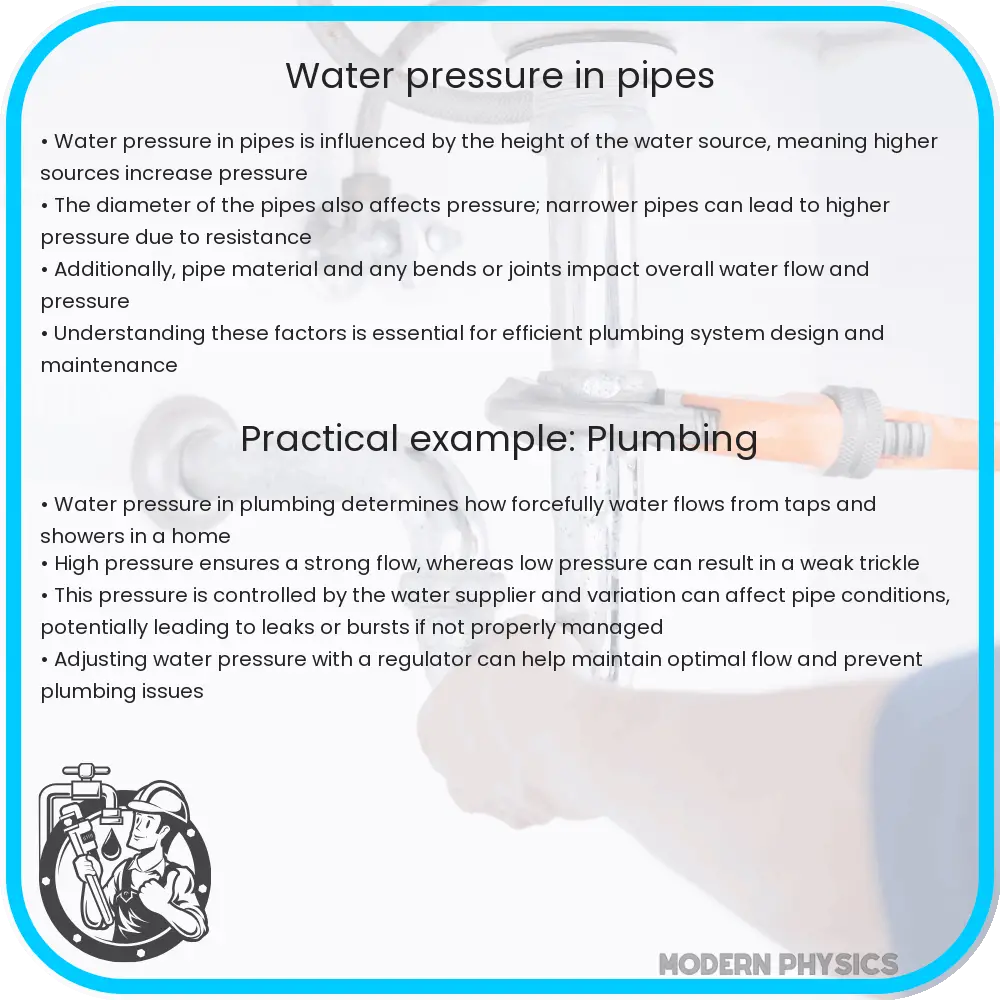Explore key concepts of water pressure in pipes, efficient flow dynamics, stress analysis, and material selection for optimal system performance.

Understanding Water Pressure in Pipes: Key Concepts for Efficient Flow and Stress Analysis
Water pressure in pipes is a fundamental aspect of fluid mechanics, pivotal for ensuring efficient flow and system stability in various applications. This article delves into the essential principles of water pressure, stress analysis in pipes, and strategies for maintaining optimal flow and stability.
Basics of Water Pressure in Pipes
Water pressure, often measured in pounds per square inch (psi) or pascals (Pa), is the force exerted by water per unit area within a pipe. This pressure is crucial for moving water through plumbing systems, irrigation, and industrial processes. The pressure in a pipe is influenced by several factors, including the water source’s elevation, pump performance, and pipe diameter.
Efficient Flow Dynamics
To achieve efficient water flow, it’s important to understand the principles of fluid dynamics. Bernoulli’s equation, given by \( P + \frac{1}{2} \rho v^2 + \rho gh = \text{constant} \), where \( P \) is the pressure, \( \rho \) is the fluid density, \( v \) is the flow velocity, and \( g \) is the acceleration due to gravity, is fundamental in this context. The equation demonstrates the relationship between pressure, velocity, and height, showing how changes in one variable affect the others.
Stress Analysis in Pipes
Stress analysis in pipes is crucial for preventing failures and ensuring long-term durability. Pipes are subjected to various stresses, including internal water pressure, external loads, and environmental factors. The key parameters in stress analysis include the material properties of the pipe, the internal fluid pressure, and the external forces acting on the pipe. Understanding the interaction between these factors is essential for designing and maintaining reliable piping systems.
Maintaining Stability in Piping Systems
To ensure stability, it’s important to consider factors such as water hammer, a phenomenon where sudden changes in water flow cause shock waves, potentially damaging the pipe system. Installing devices like pressure relief valves and employing proper pipe sizing and routing techniques can mitigate these risks. Regular maintenance and monitoring are also essential for detecting early signs of wear or damage, thus preventing catastrophic failures.
In the next section, we will explore advanced concepts in fluid dynamics and stress analysis, providing insights into cutting-edge practices for optimizing water pressure in pipes.
Advanced Concepts in Fluid Dynamics and Stress Analysis
Delving deeper into fluid dynamics, the concept of laminar and turbulent flow becomes critical. Laminar flow, characterized by smooth and orderly water movement, typically occurs at lower velocities and in smaller pipes. In contrast, turbulent flow, with its chaotic and irregular motion, is common in larger pipes and higher velocities. The transition between these two flow types is governed by the Reynolds number, a dimensionless quantity. Ensuring the appropriate flow type for a given application is essential for system efficiency and longevity.
Techniques in Optimizing Water Pressure
Optimizing water pressure involves balancing efficiency with safety. Techniques like variable speed pumps, which adjust flow rate based on demand, and pressure regulating valves, ensuring consistent pressure levels, are critical. Additionally, employing hydraulic models for system design can predict and mitigate issues like pressure surges or inefficient flow patterns.
Material Considerations in Pipe Design
The choice of material for pipes plays a pivotal role in their performance and durability. Materials such as PVC, stainless steel, and ductile iron each have unique properties that make them suitable for different applications. For instance, stainless steel offers high resistance to corrosion and temperature extremes, making it ideal for industrial uses. Understanding the chemical and physical properties of these materials is essential for selecting the right pipe for a specific application.
Environmental Impact and Sustainability
Environmental considerations are increasingly important in the design and operation of piping systems. Using materials and designs that minimize environmental impact and promote sustainability is crucial. This includes considerations for energy efficiency, reducing water wastage, and selecting eco-friendly materials.
Conclusion
In conclusion, understanding water pressure in pipes involves a multifaceted approach that encompasses fluid dynamics, material science, and environmental considerations. From basic principles like Bernoulli’s equation to advanced techniques in stress analysis and flow optimization, each aspect plays a vital role in ensuring efficient, safe, and sustainable water transportation. By integrating these concepts with practical applications and environmental awareness, we can design and maintain piping systems that meet the demands of modern society while preserving our natural resources for future generations.
